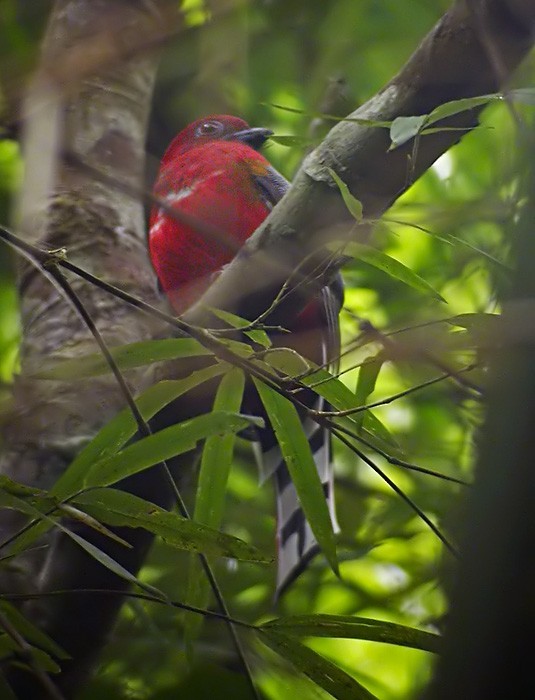Red-headed Trogon
A species of Asian trogons Scientific name : Harpactes erythrocephalus Genus : Asian trogons
Red-headed Trogon, A species of Asian trogons
Botanical name: Harpactes erythrocephalus
Genus: Asian trogons
Content
Description General Info
 Photo By Lars Petersson
Photo By Lars Petersson Description
The red-headed trogon is on average 34 cm (13 in) in length. The male has a red head and breast, a unique feature in the Trogon group. The female resembles the Diard's trogon without a speckled undertail. The head, neck and upper breast of an adult male is dull crimson. A narrow white band crosses the mid breast, underneath which the lower breast to abdomen is light red to pink. Pale red can be observed on the flanks whereas the mantle and back of the bird are rusty brown. The male perches on branches with the support of mauve-blue legs. Regarding wing colouration, the lesser and median wing coverts, secondary coverts, as well as outer webs of tertials and secondaries are vermiculated black and white. The primary feathers also appear black and white. As for the bird's long tail, the central feathers are dark brown with a black tip, the second and third pairs are black and the outer pairs are white with black bases. Finally, a black-tipped cobalt blue bill, a deep mauve-blue gape and eyering and reddish-brown irises shape the bird's face. The head, neck and upper breast of an adult female are olive-brown. Just like the male, a narrow white band crosses the mid breast, underneath which the lower breast to abdomen is light red to pink. The mantle and back appear orange to brown in colour. The wings are vermiculated dark brown and yellowish brown. The tail feathers are very similar to those of the males. The bill, gape and bare eyering are pale blue on females. At the juvenile stage, the head, neck and upper-parts are buff brown, whereas the underparts appear buff white. No black tip on the narrower central tail feathers can be observed. 
Size
35 cm
Nest Placement
Cavity
Feeding Habits
Red-headed Trogon primarily consumes insects such as orthopterans, stick-insects, cicadas, millipedes, flies, beetles, centipedes, woodlice, and moths. Occasionally, red-headed Trogon also eats leaves and fruits. It typically hunts by snatching prey from foliage.
Habitat
The red-headed Trogon primarily resides in the dense undergrowth and lower canopy of mature, broadleaf evergreen forests, with a distinct preference for the darker, moister areas and the interiors of cool ravines. It thrives within hardwood and bamboo forests and shows minimal presence in degraded forest areas. The species occupies a range of forested habitats across broader geographical regions in Southeast Asia, mostly above the lowland zones.
Dite type
Frugivorous
General Info
Feeding Habits
Bird food type

Fruit
Behavior
The red-headed trogon has often been observed perching on shaded branches waiting for prey, alone or in pairs. Its flight between trees is often sluggish and very low, only a few meters above the ground. It is most active in the early morning hours and at night, when pursuing moths at the edges of forest clearings. In central southern Thailand, it shares habitat with the Orange-breasted trogon (Harpactes oreskios). The two species often follow flocks of foraging birds taking advantage of the insects they flush out. In most regions, it is sedentary, but also been observed to migrate between different elevations in northern and southern Laos. 
Distribution Area
The red-headed trogon is widely distributed from central Nepal, Southeast Asia, southern China to Sumatra. It is uncommon to scarce in Nepal where habitat destruction most certainly explains a rapid decline in population numbers. It is fairly common in northeastern India, frequent in Bhutan, and locally dispersed in Bangladesh. It prefers upland forests and lives in dense broadleaved forests and in tropical and subtropical zones in the Himalayan foothills. In Southeast Asia, it frequents broadleaved evergreen forests from 300 to 2,600 m (980 to 8,530 ft). In Myanmar, it lives in bamboo and oak forests at an elevation of 2,500 m (8,200 ft). In Laos, it occurs in evergreen forests and adjacent plains 1,700 m (5,600 ft). The forests in Vietnam appear to be a stronghold. In northern, western and southern Thailand, it favours climax broadleaved evergreen forests between 400 and 2,000 m (1,300 and 6,600 ft). On the Malay Peninsula, it inhabits evergreen lowland, lower montane and taller upper montane forests at elevations ranging from 300 to 1,680 m (980 to 5,510 ft). Farther south, it is rarely seen below 700 m (2,300 ft). 

 Photo By Lars Petersson
Photo By Lars Petersson Scientific Classification
Phylum
Chordates Class
Birds Order
Trogons Family
Trogons and quetzals Genus
Asian trogons Species
Red-headed Trogon